Content
- Indications
- Contraindications
- Possible complications
- Preparation
- Procedure step by step
- Paraffin applications
- UHF therapy
- Inhalation
- Ultraviolet irradiation
- Microwave therapy
- Inductothermy
- Magnesium and calcium electrophoresis
- Aerosol therapy
- Magnetic laser therapy
- Care procedures after
- How long will the result last
- Advantages and disadvantages
- Video about physiotherapy for bronchial asthma
Physiotherapy is a set of procedures aimed at relieving asthma attacks, inflammatory processes and spasms in bronchial asthma. The cost of the course may vary depending on the type of exposure (1500-3500 rubles). Physiotherapy treatments for asthma are often combined with drug therapy.
Indications
Physiotherapy for bronchial asthma helps to restore respiratory activity. The course of procedures is prescribed to patients with the appearance of characteristic signs of the disease. First of all, the doctor must confirm the diagnosis. To do this, he collects anamnesis, carefully examines the patient and listens to his complaints.
Bronchial asthma can develop when the patient is prone to allergic reactions. In this case, asthma attacks usually proceed in several stages. Initially, the patient develops various vasomotor reactions from the upper respiratory tract. He complains of sneezing attacks and profuse mucous nasal discharge.
Then there is a sudden feeling of stiffness in the sternum. A person cannot breathe freely (inhalation is short and sharp, and exhalation is noisy and long). Whistling loud wheezing appears, the patient begins to suffer from an obsessive cough. Sputum is difficult to separate. The patient tries to sit up quickly, looking for a fulcrum. On exhalation, the veins located in the neck area become clearly visible.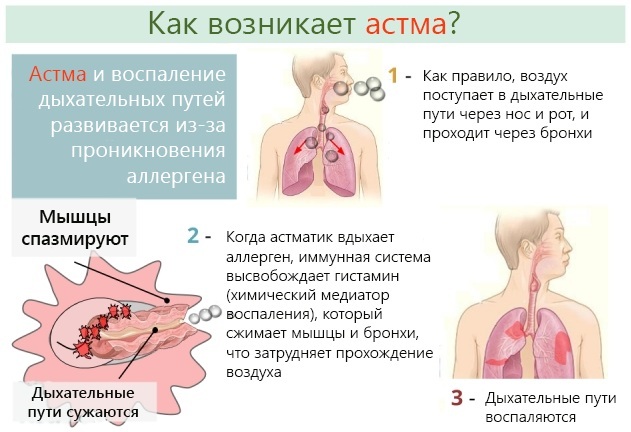
The asthma disappears as suddenly as it appears. The phlegm begins to pass away more easily, the wheezing disappears, and the state of health improves.
Contraindications
Despite the relative safety, physiotherapy procedures have a number of contraindications to their conduct.
The absolute restrictions are:
- extreme exhaustion;
- decompensated renal, hepatic, respiratory, cardiovascular failure;
- epileptic seizures;
- hemolytic, meloplastic, hemorrhagic syndrome;
- temperature jumps;
- fever;
- violation of cerebral circulation;
- pulmonary tuberculosis;
- the growth of malignant and benign neoplasms;
- allergic and pustular skin lesions.
It is necessary to refrain from carrying out physiotherapeutic procedures for patients who are in a state of drug or alcohol intoxication.
Relative contraindications also include:
- pathology of the hematopoietic system;
- infectious lesions of the skin and internal organs;
- pre-stroke, pre-infarction state.
Physiotherapeutic procedures are not performed for pregnant women in the 2-3 trimester.
Possible complications
Physiotherapy for bronchial asthma has a complex effect on the respiratory system. According to reviews, the risk of complications after the course is minimal. In extremely rare cases, due to the unprofessionalism of the specialist, the patient may get burned if the electrodes are incorrectly installed.
Preparation
Any physiotherapy procedure requires proper preparation. During the session, the patient should feel good. Any ailments that occur suddenly should be reported to a specialist. It is not recommended to eat before the physiotherapy session.
Also, the procedure is not performed on an empty stomach. Between a meal and a treatment session, at least 90-120 minutes should pass. You do not need to follow a diet, you can lead a normal life. You need to come to the session well-slept and rested.
Procedure step by step
Physiotherapy for bronchial asthma includes several types of procedures.
When confirming the diagnosis, the patient is prescribed the following procedures:
- ozokerite (paraffin therapy);
- UHF therapy;
- inhalation with a nebulizer;
- ultraviolet erythemal irradiation;
- Microwave therapy;
- inductothermy;
- electrophoresis of magnesium and calcium;
- aerosol therapy;
- magnetic laser therapy.
The above procedures differ in the mechanism of action and have different contraindications for carrying out.
Paraffin applications
Paraffin therapy is one of the methods of treating asthma and other respiratory diseases. During the session, ozokerite is used - a component of black or dark brown color, resembling wax in texture. It contains resins, mineral oils and paraffin. If necessary, after heating, the substance is mixed with essential oils and drug solutions.
Ozokerite applications have a complex effect on the body:
- stop the inflammatory process;
- restore blood circulation in the affected area;
- enhance the protective function of cells;
- start the regeneration process.
Components useful for the body quickly penetrate into the deep layers of the skin. Ozokerite has a high heat retention capacity and heat capacity. It is impossible to burn yourself with a paraffin application.
The specialist heats the ozokerite to a comfortable temperature for the skin. Biologically active components present in the composition of a substance of petroleum origin also have acetylcholine-like, estrogen-like, antibiotic, antispastic, stimulating, desensitizing and lung analgesic effect.
Before carrying out the procedure, ozokerite is placed in a paraffin heater for 10-15 minutes. After heating, the drug prescribed for the patient in this particular case is added to it.
There are several ways to apply a paraffin-like component:
- Application. Gauze is folded in 10-12 layers and placed in ozokerite. The napkin is wrung out, applied to the chest and the affected area is covered with an oilcloth diaper and a towel.
- Cuvette. Ozokerite is heated in a water bath, poured into trays no more than 2 cm thick and wait for solidification. The resulting blocks are placed on oilcloth, which covers the chest. The patient is covered with a blanket or blanket.
Also molten to 60-65 ° ozokerite is applied to the skin with a special brush. In bronchial asthma, paraffin treatment includes 15-20 procedures. The duration of one session varies from 20 to 35 minutes. Treatment with ozokerite, like most physiotherapy procedures, has a number of contraindications.
Sessions are not prescribed for people suffering from:
- thyrotoxicosis;
- thrombophlebitis;
- enterocolitis;
- tuberculosis;
- pulmonary emphysema;
- epilepsy;
- pathologies of blood vessels and heart.
In case of hypertension, the procedure is not performed.
UHF therapy
The mechanism of action of UHF therapy is based on the use of high-frequency electromagnetic fields. A special device generates heat that can penetrate into soft tissues and deep layers of the skin. The procedure has a number of contraindications.
These include:
- acute heart failure;
- hypotension;
- fever;
- the presence of thermal burns on the skin;
- hemophilia;
- lymphoma;
- leukemia;
- vasculitis;
- thyrotoxicosis;
- heart defects (including congenital forms);
- blood diseases characterized by poor clotting;
- the growth of benign and malignant neoplasms.
High-frequency magnetic therapy for bronchial asthma is not performed for people with a pacemaker.
UHF therapy helps to restore the body's defenses, eliminate spasms, edema and normalize blood circulation. The procedure is characterized by anti-inflammatory and analgesic effects. The sessions are carried out in a hospital environment using special devices capable of generating electromagnetic rays.
The specialist adjusts the device by choosing the vibration range and speed. The impact can be in an impulse or continuous manner. The patient assumes a comfortable position for him (lying or sitting). In case of bronchial asthma in the chest area, the specialist fixes the plates, having previously covered the skin with a tissue or gauze napkin. The plate elements are connected directly to the apparatus. The session lasts 15 minutes. The course includes 8-10 sessions.
Inhalation
Inhalation with a nebulizer for bronchial asthma is one of the most effective methods for delivering medicinal substances to the respiratory system. The procedure is carried out with a suffocating cough, wheezing, chest pain and slow discharge of viscous sputum. Solutions that can quickly stop an attack of bronchial asthma are poured into the reservoir of the nebulizer.
With the help of a special device, large doses of the drug can be administered.
Inhalation involves the use of medicines of the following category:
- Bronchodilators. Medicines can be included in therapy to relieve bronchospasm. In severe cases, it is possible to use several bronchodilators at the same time.
- Glucocorticosteroids. For drugs in this category, a pronounced anti-inflammatory effect is characteristic. The funds stop an attack of suffocation, prolong remission. Thanks to glucocorticosteroids, the patient can continue to lead a normal life.
Nebulizers can be used no more than 5-7 times a day. Typically, bronchial-type asthma is treated on an outpatient basis. Hospitalization for patients is required in some severe cases.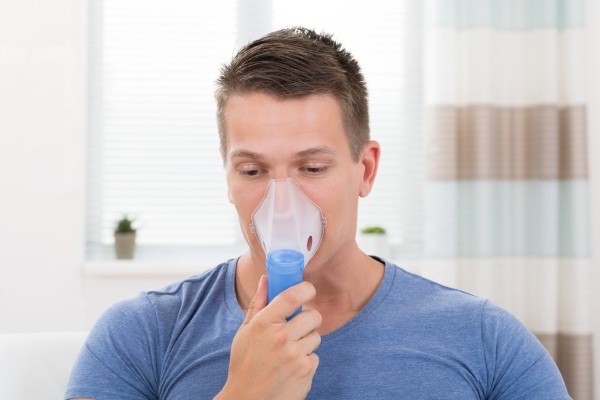
Nebulizer inhalation technique:
- the hose and mask are thoroughly rinsed with warm water and dried;
- elements in contact with the patient's skin are treated with miramistin or chlorhexidine;
- the face mask is connected to the camera by means of a special rubberized hose;
- a solution (previously prepared) is added to the tank;
- the mask is fixed on the face and the device is turned on.
The patient should breathe deeply and evenly, inhaling through the mouth and exhaling through the nose. You also need to take the most comfortable position (preferably sitting). The procedure lasts no more than 10 minutes. The course of treatment for bronchial asthma should include at least 20 sessions.
To enhance the therapeutic effect, eucalyptus, cedar or sandalwood oil, water and extracts of medicinal plants (mostly liquid) are added to the solution. After inhalation, rinse the nebulizer chamber and mask with water.
Ultraviolet irradiation
In bronchial asthma, a medium-wavelength (no more than 310 nm) study is used. The beam penetrates into the deep layers of the skin, providing a regenerating, epithelizing, analgesic, antimicrobial and anti-inflammatory effect. The procedure is carried out using a special apparatus. The specialist sets the settings on the device, choosing the intensity and mode of radiation.
A special lamp emitting a turquoise light is brought to the skin for 2-3 seconds. Parts of the body are heated alternately. Like any physiotherapy procedure, UV radiation has a number of contraindications.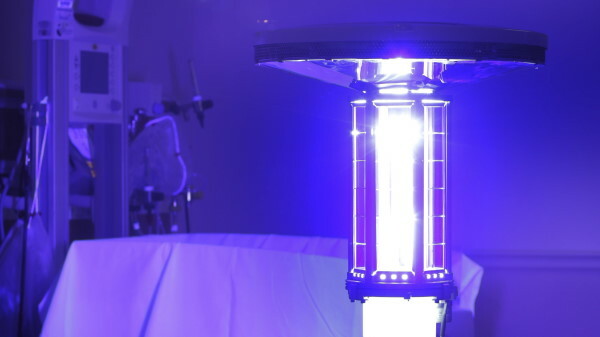
The procedure is not performed for people suffering from:
- thyrotoxicosis;
- atherosclerosis;
- hypertension;
- kidney failure;
- tuberculosis.
The growth of neoplasms of a malignant type and a tendency to bleeding are considered absolute contraindications for conducting.
Microwave therapy
Microwave therapy is also referred to as methods of treating bronchial asthma. Thermal energy acts on the skin remotely or by contact. Tissues absorb most of the rays, so the penetration depth varies within 4-5 cm.
The energy is converted into heat, which heats the tissues by 5-6 °. Under the influence of high-frequency radiation, the vascular lumen expands, blood circulation is restored. Microwave therapy also helps to activate the immune system and normalize metabolism. High-frequency rays have trophic, desensitizing, hypotensive, vasodilating, analgesic and anti-inflammatory effects.
Physiotherapy procedures are contraindicated in the following diseases and conditions:
- growth of malignant neoplasms;
- thyrotoxicosis;
- predisposition to bleeding;
- diseases of the skin of an infectious and inflammatory nature.
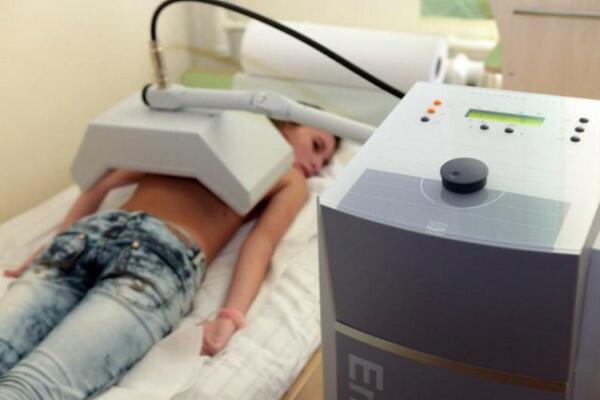
Physiotherapy for bronchial asthma
You can not carry out procedures for pregnant women and people with pacemakers.
On a special apparatus, the doctor sets the power, the frequency of electrical oscillations. If contact action is planned, then electrodes are connected to the device. They are placed on the chest. In bronchial asthma, the average power is usually set.
A session can last 25-30 minutes. (remote exposure) or 5-7 min. (contact). The course of treatment includes up to 20 procedures. Sessions are held daily or once every 2 days.
Inductothermy
With inductothermy, a certain part of the body is exposed to electromagnetic high-frequency radiation. Eddy currents are created at the cellular level. They have the maximum effect on lymph, blood and water.
Electromagnetic radiation provides heating, enhancing metabolic processes and accelerating blood flow to the affected area. Inductothermy has a vasodilator, anti-inflammatory and analgesic effect.
The procedure is carried out using a special device. A magnetic field is formed around the closed cable, which can create spiral-like vibrations. The patient should take a comfortable position for him (preferably lying). The area of the blades is covered with gauze and a hardware diffuser disk is applied to them.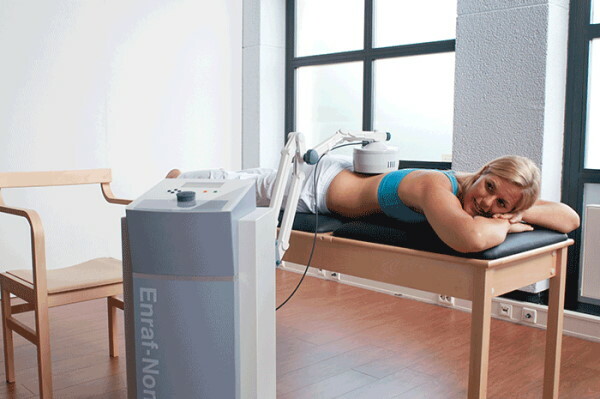
The specialist sets the degree of induction and the exposure time on the device. The session usually lasts no more than 20 minutes. The course includes up to 20 procedures. If necessary, repeat it every 6 months. Inductothermy has practically no contraindications. The procedure is not prescribed for children under 5 years old and people suffering from blood diseases, open form of tuberculosis and cardiovascular pathologies.
Magnesium and calcium electrophoresis
Electrophoresis in bronchial asthma has a complex effect on the respiratory system. During the session, it is required to use a special apparatus capable of generating an electric current and injecting drug particles into the body through the mucous membranes and skin.
Electrophoresis with magnesium and calcium in bronchial asthma contributes to:
- activation of the body's defense reactions;
- stimulation of the synthesis of bioactive substances;
- restoration of blood flow;
- relaxation of muscle fibers;
- the launch of regeneration regeneration processes;
- elimination of puffiness;
- reducing the severity of pain attacks;
- relieving inflammation.
The solution that enters the cells during electrophoresis is faster and easier to digest. The procedure has a number of contraindications.
It is not prescribed for people who are suffering,
- disorders of the psycho-emotional background;
- diseases of the liver and kidneys;
- cardiovascular insufficiency;
- oncology;
- dermatitis;
- hypersensitivity to calcium.

You should refrain from carrying out the procedure to people who, for any reason, cannot tolerate electric current. The electrodes should not be attached near burns, abrasions, wounds and other deformations of the skin.
Like most physiotherapy procedures, electrophoresis takes place in several stages. On the device, the doctor sets the intensity of exposure and the frequency of oscillations. In bronchial asthma, the cutaneous method of placing the electrodes is used. The pads must first be moistened in a solution of magnesium and calcium, and placed under the electrodes.
The latter are fixed on the skin with weights or special clamps. The procedure takes 15-20 minutes. The effect is cumulative, so the patient needs to undergo at least 20 sessions. Before electrophoresis, you need to sleep and rest well.
Aerosol therapy
Aerosol therapy can be considered an analogue of inhalation. During the session, the patient inhales fine molecules that quickly penetrate into soft tissues and are evenly distributed over them. Therapy can help stop an asthma attack.
There are several main degrees of molecular grinding:
- coarse droplets;
- fine-droplet;
- low dispersed;
- medium dispersed;
- highly dispersed.
In bronchial asthma, low-dispersed or small-droplet particles are usually used. When using large structures, the solution will not enter the bronchi, it will remain in the trachea and larynx.
According to the temperature regime, the following types of aerosols are distinguished:
- hot;
- warm;
- indifferent;
- cold.
In bronchial asthma, it is advisable to use the intrapulmonary route of administration. The solution goes directly into the bronchi and bronchioles. Aerosol therapy has a number of contraindications.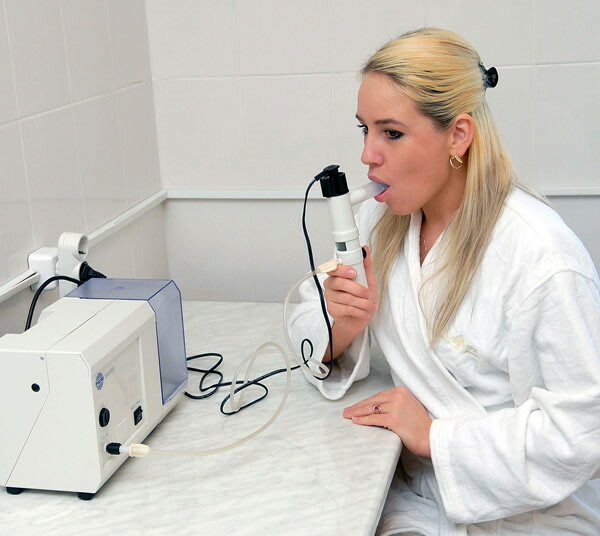
These include:
- hypertension;
- tendency to allergic reactions;
- intolerance to substances in the composition of bronchodilators;
- pulmonary, heart failure;
- emphysema of the lungs;
- pneumothorax;
- pulmonary bleeding.
Experts recommend using oil, wet, heat-moist and steam inhalers during aerosol therapy. The procedures can be carried out up to 5 times a day. The course of treatment is 20 days.
Magnetic laser therapy
MLT (magnetic laser therapy) is a method of physiotherapeutic treatment, the principle of which is based on the effect of a low-intensity laser beam and a magnetic field on the respiratory organs. MLT allows you to stop an attack of bronchial asthma. Laser infrared rays penetrate deeply into soft tissues, helping to restore microcirculation and metabolism.
They also strengthen the body's defenses. Under the influence of laser radiation, the processes of recovery and regeneration are triggered. The body receives the required amount of nutrients.
The procedure is not carried out when:
- pulmonary insufficiency;
- lupus erythematosus;
- photoophthalmopathy;
- hepatic, renal and cardiovascular failure;
- anemia;
- diseases of infectious etiology (during an exacerbation);
- malignant and benign neoplasms.
Children's age can also be considered an absolute contraindication. Thyrotoxicosis, photodermatosis, porphyria are considered relative limitations. Women during the period of carrying a child and breastfeeding should also refrain from MLT.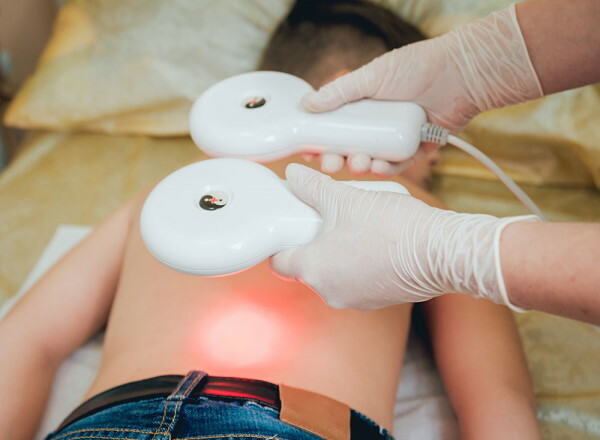
The procedure does not require special preparation. The patient should get rid of his outer clothing and lie down on the couch. The specialist attaches the plates to the skin. The application of any gel is optional. During the procedure, the patient must remain calm. According to reviews, a person does not experience any discomfort at this time. The session lasts 15 minutes. The course of treatment includes 10-15 procedures.
Care procedures after
Physiotherapy for bronchial asthma does not change the patient's usual lifestyle in any way. After the procedure, the patient should remain emotionally calm. It is advisable to temporarily abandon active sports - experts do not recommend overloading the body. Dieting is not required, and there is no need to make adjustments to your usual diet.
How long will the result last
According to reviews, the effect after physiotherapy procedures lasts for several months. Attacks of bronchial asthma occur less frequently, the disease flows into the stage of remission. It is impossible to completely recover from the disease, therefore, patients need to undergo physiotherapy courses every 3-6 months.
Advantages and disadvantages
Physiotherapy for asthma has several benefits. These methods of exposure for the bronchial type do not imply injury to soft tissues, mucous membranes and skin. The therapeutic effect of current, infrared rays and a magnetic field enhances the therapeutic effect of medicines.
One of the main advantages of therapy is the absence of side effects. Patients do not develop dependence upon discontinuation of a particular drug. The disadvantage of physiotherapy procedures is the presence of an extensive list of contraindications. Most treatments are not suitable for children and pregnant women.
Many patients also attribute a high price to the disadvantages:
| Procedure type | Cost (per course) |
| Paraffin therapy | From 3000 rub. |
| UHF therapy | From 2500 rub. |
| Inhalation | From 2200 rub. |
| UV irradiation | From 3200 rub. |
| Microwave therapy | From 1800 rub. |
| Inductothermy | From 2000 rub. |
| Electrophoresis | From 2000 rub. |
| Aerosol therapy | From 2500 rub. |
| Magnetic laser therapy | From 3000 rub. |
It is necessary to make an appointment only with a highly qualified specialist. When choosing a clinic, you cannot rely on advertising and the opinion of unfamiliar people.
Physiotherapy procedures for bronchial asthma prevent the development of complications. They can be combined with drug treatments for pathology. It is advisable to undergo the procedures daily.
Video about physiotherapy for bronchial asthma
Therapeutic exercises for asthma:



